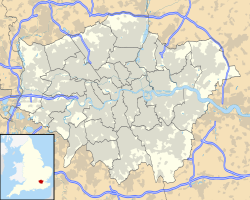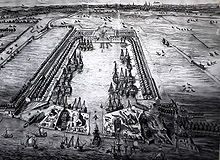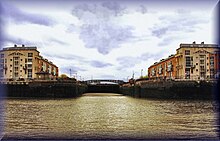Greenland Dock
Location of the Greenland Dock in Greater London |
The Greenland Dock is the oldest of London's docks on the Thames; it is located in Rotherhithe and is now part of the Docklands . It was part of the Surrey Commercial Docks , most of which are now filled in. The Greenland Dock is now used exclusively as a recreational area. It is one of only two unfilled docks on the south bank of the Thames .
history
Howland Great Wet Dock
The harbor basin was built between 1695 and 1699 on land that belonged to the noble Russell family of the 1st Duke of Bedford. The Russells had got the property in the lower Rotherhithe from a wealthy landowner from Streatham , John Howland. It was part of the dowry for his daughter Elizabeth, granddaughter of Sir Josiah Child - the dictatorial chairman of the East India Company - who married Wriothesley Russell , the Marquis of Tavistock. They immediately tried to “improve” the agriculturally used property and in 1695 received parliament's permission to build a rectangular harbor basin with an area of approx. 4 hectares that could accommodate approx. 120 ships. In honor of John Howland it was called "Howland Great Wet Dock". The harbor basin was designed by local shipbuilder John Wells and should be sufficient for East Indiamans.
In the drawing from 1717 the new harbor basin can be seen in a rural setting a few miles outside of central London (then much smaller). It had rows of trees on three sides to serve as a windbreak, and at the west end was the Russell family mansion. Unlike the later docks, Howland Great Wet Dock had no quay walls, warehouses or other facilities necessary for merchant shipping, as it was not designed for these. Instead, it was intended to "allow ships to enter and exit without difficulty, without having to move other ships." It was essentially an equipment base for ships where they could be repaired and remain in a safe anchorage. The proximity to the shipyard in Deptford was advantageous for this purpose .
Whaling and timber trading
From the 1720s onwards, whaling ships returning from Greenland also used the harbor basin and large bubbling boilers were built on the south side of the harbor to produce whale oil. In 1763 the Howland Great Wet Dock was sold by John Russell, the 4th Duke of Bedford. The occasional use of the basin by Greenland whalers resulted in the name being changed to Greenland Dock . However, this use decreased rapidly at the beginning of the 19th century.
In 1806 the docks were sold to William Richie , a lumber merchant from Greenwich , who founded the Commercial Dock Company in 1807 . The company built a number of additional docks and two new wooden ponds in the north, while competitors also built additional docks, creating a mess of various docks, canals and wooden ponds. In 1865 this company merged with its neighbor, the Surrey Docks Company, to form the Surrey Commercial Docks Company , which handled about 80% of the timber trade in London.
The Greenland Dock was the center of London's timber trade for over a century. On its shores, warehouses and huge piles of wood were built, which were shifted by athletic "wooden beams". Most of the wood arrived on small sailing ships from the Baltic States ; later it was loaded onto large steamers.
Expansion and decline
In 1895-1904, Greenland Dock was extensively extended westward at a cost of £ 940,000, a project planned and carried out by Sir John Wolfe-Barry , the engineer who also built Tower Bridge . Its length was more than doubled and its depth almost doubled, so that in the final stage it had a water surface of 9.1 hectares with a length of 690 m and a depth of 9.4 m, as well as the Grand Surrey Canal . It also got a large lock basin, 170 m long, 24 m wide and 11 m deep. This conversion enabled the port basin to accommodate large cargo ships and even ocean liners. A-class ships of the Cunard Line with up to 14,000 GRT , powered by large steam engines, regularly transported passengers and cargo from Greenland Dock to the Saint Lawrence River in Canada and back. So far up the river they were considered large ships and had to turn on the river in order to enter the lock.
In 1909, the Greenland Dock, like all other docks in London, was merged into the Port of London , which was run by the Port of London Authority .
In the same period as the large steamers, there were, in contrast, barges less than a tenth the size that brought wood from Finland - survivors of the sailing age with three or four masts and representatives of the Baltic timber trade. Finland Quay , Swedish Quay , Norway Dock and Russia Dock were some of the names that came from the original timber trade in Rotherhithe.
The Greenland Dock suffered badly from the Second World War , as many warehouses fell victim to the hail of German bombs and the lock was also rendered unusable by air raids. After the war, the facilities were quickly repaired and once again experienced a brief period of prosperity. But the technical changes in the shipping industry soon resulted in an accelerated decline in trade in the harbor basin. The profession of timber carrier was abolished in 1958 because the timber was now only transported in bundles. A little later, container ships that were much too big to enter the London docks began to appear. In 1970 the Surrey Commercial Docks were closed. The Greenland Dock was sold to the Southwark borough council .
Urban development
The Surrey Docks lay fallow for over 10 years, with almost all warehouses demolished and 90% of the docks refilled. The Greenland Dock, which was now in the hands of the district administration, escaped this fate and was handed over to the London Docklands Development Corporation (LDDC) in 1981 . At that time, the Inner London Education Authority (ILEA) was operating a Surrey Docks Watersport Center on the harbor basin from a few portable cabins on Redriff Road . Many young people who had previously had no contact with sailing or canoeing were trained in this center. A master plan was drawn up to relocate remaining industrial users to the quays and convert them into a residential area. This plan was implemented in the late 1980s and seven residential complexes were built in place of the earlier warehouses, all of which were named after them: the Swedish Yard became the Swedish Quay , the Brunswick Yard became the Brunswick Quay , and the Baltic Yard became the Baltic Quay etc. Today the area is dominated by luxury residential complexes such as B. the Greenland Passage Development or the completed New Caledonian Wharf . In addition, a new water sports center was built at the former entrance to the now filled Grand Surrey Canal . This has ensured that the harbor basin has remained a popular spot for windsurfing , canoeing and even Chinese dragon boat races .
In contrast to the earlier entrances and exits, the harbor basin itself is largely undamaged. All but one of these have been backfilled or blocked. There is also a service link to the South Dock , which has now become a marina, and Greenland Dock also has a small marina of its own at the east end. There is no trace of the former warehouses, although part of the former capstan and some of the hydraulic machinery for operating the lock on the quays have been preserved.
The alternative comedian Malcom Hardee drowned in this harbor in 2005 when he tried to row to his houseboat from the Wibbley Wobbley , a ship at the Thames end of Greenland Dock that is used as a pub.
Transport links
The nearest train station is Canada Water on the Jubilee Line and East London Line . The "water bus" by Thames Clippers operates the Greenland Dock Pier . The Thames Path long distance hiking trail runs along the south bank of the Thames.
Web links
- John Butler: Rotherhithe , description and photos by Rotherhithe
- Greenland Passage Development ( English ) Greenland Passage (1996) Ltd. Archived from the original on March 14, 2016. Retrieved April 25, 2019.
literature
- Stuart Rankin: Shipbuilding in Rotherhithe, Greenland Dock & Barnard's Wharf . Bib ID 482821
- Stuart Rankin: Shipbuilding in Rotherhithe - An historical introduction . Bib Id 488375, pp. 5-6





